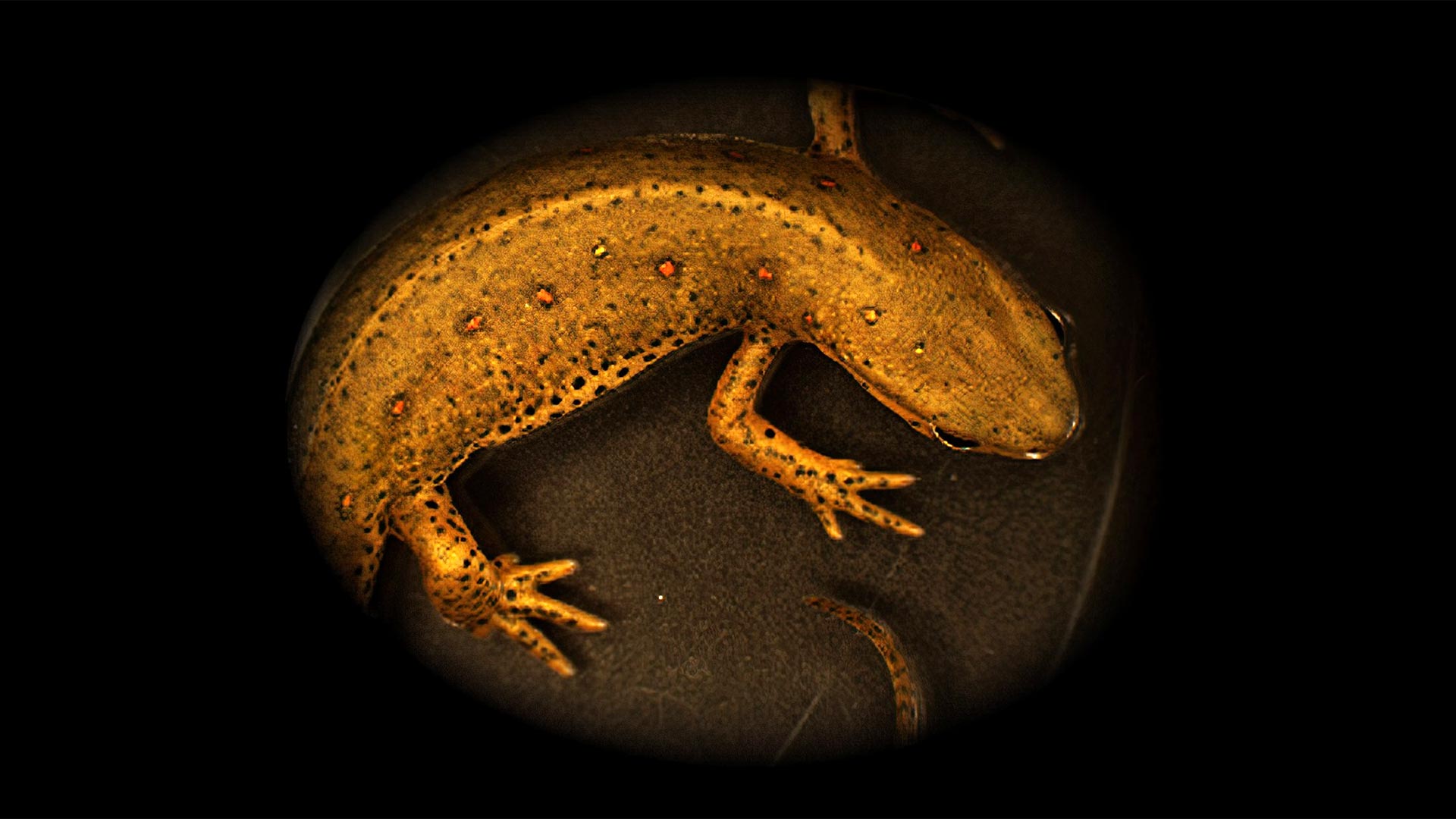Druh mloka studovaný Yoonovou skupinou: Mlok červenoskvrnný Notophthalmus viridescens. Studiem mloků, kteří mají pozoruhodné regenerační schopnosti, vědci zjistili, že přítomnost senescentních buněk urychluje proces regenerace končetin. Buňky vylučují faktory, které signalizují zralým svalovým vláknům, aby se přeměnily na bývalé svalové buňky, což podporuje regeneraci. Toto zjištění by mohlo výzkumníkům pomoci pochopit, proč mají lidé omezené regenerační schopnosti a možná vyvinout nové způsoby léčby nemocí souvisejících s věkem. Kredit: Maximina Yun
Vědci prokázali, že takzvané senescentní buňky, tedy buňky, které se trvale přestaly dělit, podporují tvorbu nových svalových buněk, které podporují regeneraci ztracených končetin u mloků.
Senescentní buňky, spojené se stárnutím a nemocemi, mohou mít regenerační vlastnosti. Studiem mloků vědci zjistili, že senescentní buňky urychlují regeneraci končetin tím, že signalizují svalovým vláknům, aby se dediferencovali, což by mohlo vést k nové léčbě nemocí souvisejících s věkem.
Senescentní buňky jsou buňky, které se trvale přestaly dělit v reakci na buněčný stres, ale nezemřely. Jak organismy stárnou, počet senescentních buněk v těle se zvyšuje. Toto nahromadění je v současnosti považováno za charakteristický znak stárnutí a je spojováno s řadou onemocnění, včetně rakoviny. Skutečná povaha těchto buněk však může být složitější a závislá na kontextu.
Rostoucí množství důkazů naznačuje, že senescentní buňky mohou mít také příznivé účinky, jako je hojení ran nebo předcházení zjizvení tkání. „Před několika lety naše skupina zjistila, že senescentní buňky byly přítomny v klíčových fázích regenerace končetin mloka. Je zajímavé, že další skupiny následně našly tyto buňky v jiných kontextech regenerace, včetně savců. Proto jsme chtěli zjistit, zda tyto buňky přispívají se může jakýmkoliv způsobem obnovovat,“ vysvětluje Dr. Maximina Yon, vedoucí výzkumné skupiny Centra pro regenerační terapie Drážďany (CRTD) a skupiny Physics of Excellence (PoL) na TU Dresden a Institutu Maxe Plancka v[{“ attribute=““>Molecular Cell Biology and Genetics (MPI-CBG).
Senescent Cells Promote Regeneration
The researchers in Yun’s group study salamanders. These animals have unique regeneration abilities and are able to re-grow many organs of their bodies, including lost limbs. “Salamander limb regeneration is a fascinating process. In a matter of weeks, they re-grow a fully functional limb,” explains Dr. Yun.
To check if the presence of senescent cells influences the limb regeneration process, researchers in the Yun group found a way to modulate the number of senescent cells in the wound. The team observed that the presence of senescent cells enhanced the regeneration process.
“When more senescent cells were present in the wound, the animals developed a larger regeneration bud, or – as we call it – blastema. This is a collection of cells that are going to form all the needed tissues in the new limb. The larger the blastema, the more cells are there to regrow the limb and the quicker the regeneration process. The presence of senescent cells seemed to ‘fuel’ the regeneration process,” Dr. Yun says.
“Zombie” Signaling Promotes New Muscle Cells
Looking more closely at the blastema with and without the influence of the senescent cells, the Yun team uncovered a new mechanism that enhances the regeneration process and found that the presence of senescent cells increased the number of regenerating muscle cells. They showed that senescent cells secrete factors that stimulate nearby muscle tissue to take a developmental step back and produce new muscle.
“Our results show that senescent cells use cell-cell communication to influence the regeneration process. They secrete molecules that signal to mature muscle fibers to dedifferentiate into muscle progenitor cells. These cells can multiply themselves as well as differentiate into new muscle cells, thereby enhancing the regeneration process. This signaling appears to be an important part of promoting regeneration,” says Dr. Yun.
For now, the group focused on muscle, one of the most important tissues in the regenerating limb. However, the team is already investigating whether senescent cell signaling also contributes to the regeneration of other tissues.
Lessons From the Salamanders
Yun’s group is working with salamanders to study regeneration and aging processes. “Salamanders are one of the few animal species that seem to defy the natural aging process. They do not develop typical signs of aging and do not accumulate age-related diseases such as cancer. They also have extraordinary healing abilities,” says Dr. Yun. The animals can regenerate almost any organ in their body.
Studying salamanders is helping Dr. Yun and her colleagues at the CRTD understand the principles of the regeneration process and, in the long run, may help solve the puzzle of why humans have very limited regenerative abilities.
Reference: “Senescent cells enhance newt limb regeneration by promoting muscle dedifferentiation” by Hannah E. Walters, Konstantin E. Troyanovskiy, Alwin M. Graf and Maximina H. Yun, 6 April 2023, Aging Cell.
DOI: 10.1111/acel.13826

„Unapologetický analytik. Rozzuřeně skromný kávový evangelista. Hráč. Nelze psát s boxerskými rukavicemi. Student. Podnikatel.“
You may also like
-
Vědci tvrdí, že mají „dosud nejsilnější statistické důkazy“, že v naší sluneční soustavě je ukryta planeta
-
Lovci zemřeli po konzumaci infikované zvěřiny
-
„Ďábelská kometa“ 12P/Pons-Brooks míří ke Slunci. přežijete?
-
Potraviny a nápoje, které podle lékařů způsobují bolesti kloubů
-
Jádro Pluta bylo pravděpodobně vytvořeno starověkou srážkou

